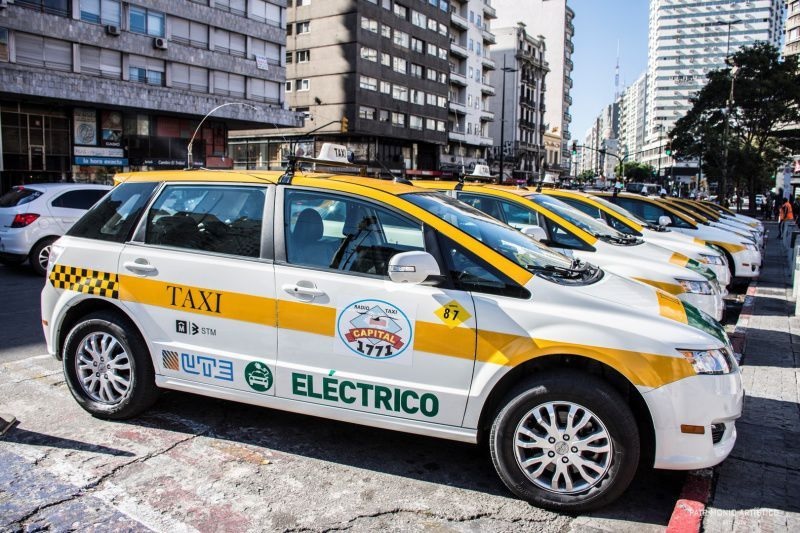In an effort to move towards more sustainable mobility and reduce carbon emissions, several countries in Latin America are embracing the incorporation of electric taxis in their major cities.
Backed by governmental support, programs for transitioning to electric taxis feature subsidies and assistance to promote their development and integration into everyday use.
In this article, Mobility Portal Latinoamérica compiles a list of the different programs currently in effect in Latin America and sheds light on the regional landscape.
Brazil
The country was one of the pioneers in implementing electric taxis in South America.
According to official data, pilot tests were conducted in 2012 with ten Nissan Leaf electric vehicles (EV) in Sao Paulo and 15 in Rio de Janeiro operating as municipal taxis.
The LEAF electric taxi program in Rio de Janeiro is part of a partnership promoting zero-emission mobility in the city.
This initiative involves Nissan, the distributor Petrobras responsible for electric vehicle charging infrastructure, and the “Rio Capital of Energy” project.
For the pilot test in Sao Paulo, the alliance was formed between the City Hall, Renault-Nissan, AES Eletropaulo, and Adetax (the Taxi Association of Sao Paulo).
While it was reported that the programs “prevented the emission of 75 tons of CO2” after one year of implementation, there is currently no information available on their current status.
On another note, in 2022, councilors in Belo Horizonte introduced a bill aimed at introducing electric buses and taxis in the capital of Minas Gerais.
Regarding municipal taxis, they prioritized facilitating vehicle exchange to positively impact the lives of drivers.
However, it was not approved by the City Hall.
It’s worth noting that in 2017, the Belo Horizonte Transport and Traffic Company (BHTrans) and the Chinese automaker BYD joined forces to launch electric taxis.
Chile
Since 2021, Chile has the “My Electric Taxi” program by the Ministry of Energy, implemented by the Energy Sustainability Agency.
Through the initiative, concrete support is provided for owners of basic and urban collective taxis to exchange their vehicle for an electric one.
The program co-finances the acquisition of the electric vehicle and finances the delivery and installation of the corresponding electric charger for taxi owners who qualify.
In its first version, it replaced 50 combustion vehicles used as basic taxis with electric vehicles in the city of Santiago.
A survey of the initial beneficiaries revealed that, in the first version, participating taxis traveled an average of 37,000 kilometers in a year, resulting in an average savings of over 3 million chilean pesos.
Even one driver, who drove over 100,000 kilometers, achieved savings exceeding 10 million chilean pesos.
In its second version, benefits were extended to 80 basic, executive, or urban collective taxis.
On their website, they offered 7 available models with original price ranges between 25 and 35 million chilean pesos.
Co-financing is up to 16 million chilean pesos, with priority given to the regions of Valparaiso, Metropolitan, Biobio, Los Rios, Araucania, and Aysen.
In recent years, “My Electric Taxi” has become a platform for the introduction of new rechargeable cars.
Despite the variety of available models, in this latest version, all 70 slots were taken by the automaker BYD.
The Asian company accounted for 100 per cent of the selection, divided among the three models it offers under the program: Yuan Plus GL, Yuan Plus GS, Dolphin, and D1.
Additionally, in February of this year, the Ministry of Energy and the Energy Sustainability Agency (AgenciaSE) launched the initiative “+Electric Transport”.
The contest includes co-financing for the purchase of an electric vehicle and its residential charger, including installation, with amounts ranging from 15,000,000 to 19,000,000 chilean pesos.
Ten benefits will be awarded per region to owners of an urban collective taxi living in the communes of Antofagasta, Calama, Talca, Linares, Curico, Puerto Montt, Castro, and Osorno.
The aim is to encourage female participation in the energy and transportation sectors, so slots will be allocated based on gender equity criteria during the first month.
Colombia
Empresas Públicas de Medellín (EPM) and the Medellín City Hall have been working on the incorporation of electric taxis since 2020.
In 2022, they launched a call to incorporate up to 500 new units, with a focus on scrapping internal combustion engine vehicles.
Their 2×1 initiative proposed that interested parties could use the same operating card for their electric unit while continuing to work with both vehicles simultaneously for five years.
This allows them to have two incomes to cover the incorporation expenses.
Once that time has passed, the combustion vehicle would be scrapped, and the electric one would remain valid.
However, this idea did not succeed, and approximately one year after its launch, only 19 of the promised 500 vehicles are in circulation.
The Medellín City Hall attributes this strategy’s failure to three factors: vehicle costs, limited availability, and changes in interest rates by banking institutions.
In light of this situation, electric vehicle drivers also encounter difficulties in carrying out their work, as most chargers are out of service.
Nevertheless, there is also a push for the proliferation of electric taxis in other regions of Colombia.
Recently, the governor of Cali, Dilian Francisca Toro, presented a sustainable mobility project to the Minister of Transportation, William Camargo, aiming to provide alternatives to taxi drivers to reduce their operating expenses.
The governor mentioned a vehicle replacement fund held by the Ministry of Transportation, stating, “The idea is to replenish taxis for drivers, giving them the resources so that we can change at least 300 taxis.”
It is important to note that during his tenure as Mayor of Bogotá, Gustavo Petro promoted the transition to electric fleets along with the C40 Electric Vehicle Program – Clinton Climate Initiative (CCI), Codensa (now Enel-Codensa), the Mobility and Environment secretariats, and BYD car company.
The agreement was signed in 2011, but the pilot project with 50 electric vehicles did not commence until September 2013.
From that date, electric vehicle owners had ten years during which they did not have to pay for their taxi licenses and were exempt from vehicle restrictions based on license plate numbers.
Costa Rica
Costa Rica introduced E-taxiCR, an initiative led by the CRUSA Foundation and the Ministry of Environment and Energy (MINAE), with the implementation supported by the United Nations Environment Programme (UNEP), and financial backing from the Global Environment Facility (GEF).
It’s a pilot project that has been underway since October and allows tourists and users of the Juan Santamaría International Airport to travel in electric taxis.
The pilot plan involves the launch of six electric taxis, which will be monitored for a year to generate data – firsthand – and experiences that will help determine performance, autonomy, charging patterns, and costs, supporting the scaling up of electric public transportation in the sector.
Ecuador One of the goals of Ecuador’s National Electromobility Strategy (ENEE) is to reach 10,000 electric vehicles by 2025.
To achieve this, it is planned to have 1,500 buses, 2,000 taxis, one thousand light-duty trucks, and 5,500 light cars in circulation.
Fleets of electric taxis are found in Loja, Guayaquil, and Quito.
In Loja, the project began in 2016 with 50 units but did not yield positive results.
In 2022, due to ordinance changes and lack of responses in the country, many taxi drivers opted to switch to gasoline vehicles to continue their work.
In Guayaquil, the Municipality and the Municipal Transit Authority (ATM) introduced the first 50 BYD electric taxis in 2020.
The government offered a 4,000 dollars incentive to taxi drivers who switched from combustion vehicles to electric ones.
Additionally, BYD provides a discount of the same amount to promote access to electric mobility in the city.
Mexico
Mexico has the Individual Public Transportation Financing Program that allocates higher amounts for financing electric taxis in Mexico City (CDMX).
The requirements for applying to the program include the regularity of the concession, scrappage of units over ten years old, and having suitable financial conditions.
The amount ranges up to 180,000 Mexican pesos, with support ranging from 25 to 40 per cent of the unit’s cost.
Uruguay
The Ministry of Industry, Energy, and Mining (MIEM), through the Subite Pasajeros program, subsidizes the purchase of electric vehicles to replace taxi, remise, and app-based public transport units.
The aid amounts to 5,000 dollars for permit holders who replace their fossil-fueled cars with electric ones throughout the entire national territory.
Furthermore, to continue with the decarbonization plan of the economy and sustainable mobility, the Montevideo Intendancy issued a call for bids in October 2022 for the allocation of 20 permits for electric taxis.
Based on the 17 million pesos collected, a new subsidy was implemented to finance the replacement of 85 taxis with fossil fuel engines with brand-new electric units.
This financial tool involves granting 200,000 Uruguayan pesos for each vehicle replaced under these conditions.
Additionally, within the 85 slots, 30 will be reserved for taxi cooperatives.







